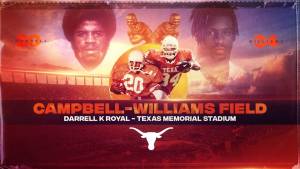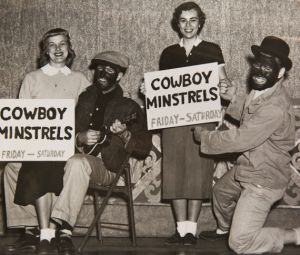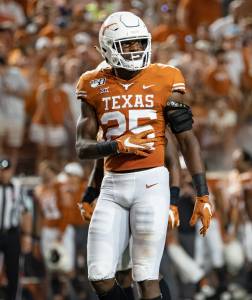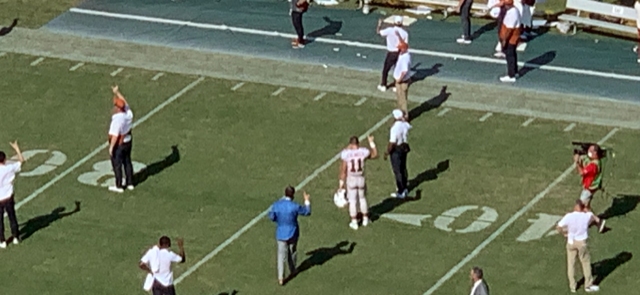After I got a University of Texas diploma on May 22, 1976, the decades have rolled by. That’s one form of distance, another being the 6,000 or so miles separating the USA from Korea. If the bonds between me and my alma mater are not as strong and immediate as before, they will never be fully broken; I do attend a gathering of alumni every December at a hotel in Seoul. I am here to provide a few words of mature commentary about UT.
It may not rival Minneapolis, Portland or Seattle, but Austin has seen its share of protesting and rioting in the last five months. Needless to say, the issue is the only-black-lives-matter movement. Even before that, the pot was boiling. Statues of Robert E. Lee, Albert Sidney Johnston, John Reagan, Jefferson Davis, James Stephen Hogg and Woodrow Wilson have been removed from the main mall in the last five years to remote places in campus libraries and museums. Six once-adulatory shrines are gone, and now we have six empty pedestals in the very heart of the 40 Acres. Far be it from me to deny the long shadow of the Confederacy, but Texas has by fits and starts advanced. It was neither unusual nor frowned on even in the early 1960s for the Rebel flag to be waved at Memorial Stadium on game days.
we have six empty pedestals in the very heart of the 40 Acres. Far be it from me to deny the long shadow of the Confederacy, but Texas has by fits and starts advanced. It was neither unusual nor frowned on even in the early 1960s for the Rebel flag to be waved at Memorial Stadium on game days.
Ah, King Football! The issue is not so much that the Longhorns lost to Oklahoma on October 11, falling out of the top 25 and sparking rumors that Tom Herman is on the hot seat. (Will the fourth-year coach quit or be fired? If it’s the latter, the buyout will range from $15 million to $20 million.) In 2019, Earl Campbell advocated for mono-cultural football by asserting that the Horns could not win with a White quarterback. He damned Sam Ehlinger—a White player who has held that position for the last three-plus seasons—with faint praise and called for a black QB. If there is another White player on the starting offense and defense at UT, I am not sure of his identity; the team is heavily, overwhelmingly black.
Before going any further, I will point out that Ehlinger, 6′3″ and 220 pounds, is an excellent athlete and fierce competitor. He has thrown for more than 10,000 yards, with an 84/26 touchdown/interception split, rushing for 1,768 yards and scoring 30 times himself. If Ehlinger is not the second coming of Vince Young, those are still some very nice statistics. Many a time he has carried the team on his shoulders. Herman has not made him the QB due to his race but his football skills, and even Campbell should know that.
In the very turbulent summer of 2020, black football players did not hesitate to express themselves. A number of them informed Herman and athletic director Chris Del Conte that they would not participate in the usual hosting of recruits and other donor-related events until their demands were met. The extent to which their White teammates voluntarily went along is anyone’s guess. They insisted that:
in the usual hosting of recruits and other donor-related events until their demands were met. The extent to which their White teammates voluntarily went along is anyone’s guess. They insisted that:
- the UT athletic department donate 0.5% of its annual earnings to the only-black-lives-matter movement and other black organizations;
- an exhibit dedicated exclusively to black athletic history at UT be established;
- Julius Whittier (UT’s first varsity black football player) be honored in a tangible way, such as the erection of a statue;
- some campus buildings named after persons they found offensive be renamed;
- UT’s history of racism be more openly acknowledged; and
- “The Eyes of Texas,” the school fight song, be consigned to the dustbin of history.
To put this situation in some context, it was not just the Texas football team but athletes representing the basketball, volleyball and soccer programs who signed a petition, along with more than 100 student organizations. Much the same happened simultaneously at just about any American educational institution you care to name: black college jocks were flexing their muscle. President Jay Hartzell, Del Conte and Herman all responded by placating, appeasing and mollifying. A series of “diversity initiatives” was quickly unveiled.
In my view, the demands range from reasonable to breathtakingly audacious. I will not try to address all of them. The fourth listed is one with which I have no problem. T.S. Painter, George Littlefield, Robert Lee Moore and James Stephen Hogg have been adjudged guilty of various sins. Moore, a fine  mathematician and teacher, was blatantly racist to black students who took or tried to take his classes until his retirement in 1970. This being the case, I think it is right and proper for his name to be removed from what is now the Physics-Math-Astronomy Building. He’s reaping what he sowed.
mathematician and teacher, was blatantly racist to black students who took or tried to take his classes until his retirement in 1970. This being the case, I think it is right and proper for his name to be removed from what is now the Physics-Math-Astronomy Building. He’s reaping what he sowed.
As for Whittier, I want to state once again that I knew him, respected him and truly loved him. I recognize the value of what he did in integrating the Texas program. But if he merits a statue, what about Jerry LeVias of SMU? He preceded Whittier by four years and dealt with far more adversity. And any comparison of the two men’s college football careers is massively weighted toward LeVias. Why, I would ask the SMU administration, was no statue put up a long time ago? Why on earth has his number (23) not been retired?
The field at Memorial Stadium was named after big-bucks alumnus Joe Jamail in 1997. I did not approve, any more than calling this great and historic arena “Darrell K Royal-Texas Memorial Stadium.” DKR, as I have written exhaustively, sat on his hands during the crucial integration years. Jamail’s three sons offered to remove the name of the old man (d. 2015), and the university gladly accepted. Now we have Campbell-(Ricky) Williams Field, in honor of our two Heisman Trophy winners. I contend this was more about race than football greatness. UT would have had a lot of explaining to do if Bobby Layne, Jimmy Saxton or Steve Worster had won in 1947, 1961 and 1970, respectively. They came close. The alternative I proposed to a couple of guys on the sports staff at the Austin American-Statesman was to call it Nobis-Campbell-Williams Field. Tommy Nobis, a White man, remains beyond doubt the finest linebacker or defensive player UT has ever produced. By including him, we would have been standing up for the ideal of racial harmony. Alas, my idea gained no traction.
Jimmy Saxton or Steve Worster had won in 1947, 1961 and 1970, respectively. They came close. The alternative I proposed to a couple of guys on the sports staff at the Austin American-Statesman was to call it Nobis-Campbell-Williams Field. Tommy Nobis, a White man, remains beyond doubt the finest linebacker or defensive player UT has ever produced. By including him, we would have been standing up for the ideal of racial harmony. Alas, my idea gained no traction.
I hate to put too fine a point on it, but what is to be done the next time a Longhorn wins the Heisman? Is his name automatically appended to those of Earl and Ricky? The worst-case scenario, of course, would be if a White player were to win it. Had Texas beaten TCU and OU, Ehlinger would have been on a short list of candidates to bring that 45 pounds of bronze back to Austin. Such delicious irony that would have been!
Where the OBLM crowd overreached was in calling for the removal of “The Eyes of Texas” as the school’s fight song. There is a long and convoluted history about the origins and adoption of this ditty, which is sung to the tune of “I’ve Been Working on the Railroad.”
The Eyes of Texas are upon you,
All the livelong day.
The Eyes of Texas are upon you,
You cannot get away.
Do not think you can escape them,
At night or early in the morn.
The Eyes of Texas are upon you,
’Til Gabriel blows his horn.
The lyrics seem pretty innocuous to me, a person of European descent, although a student with pernicious critical race theory imprinted on his or her brain might disagree. The main problem is that the song debuted at a 1903 campus minstrel show where students sang it in blackface. In fact, blackface performances were still being given at UT in the 1940s. I never devoted much thought to “The Eyes” until last summer, but really this is too much. Some powerful and wealthy alumni feel the same way. They told Hartzell—and by extension Del Conte and Herman—that it is a deeply ingrained part of UT’s culture, something they cherish. Their message was along this line: “If you get rid of ‘The Eyes of Texas,’ I will stop writing checks or at least write smaller ones.”
Funding of higher education by the Texas Legislature has been shrinking for a long time. Alumni and other friends of the university have been asked to make up the difference. (They continue to badger me, even  though I have never given a cent.) Push had come to shove, and Hartzell had no choice but to say “The Eyes” stays. Of course, it was done in a mealy-mouthed way. The president averred that UT would try to “reclaim and redefine” the song.
though I have never given a cent.) Push had come to shove, and Hartzell had no choice but to say “The Eyes” stays. Of course, it was done in a mealy-mouthed way. The president averred that UT would try to “reclaim and redefine” the song.
Perhaps you are aware that the south end of Memorial Stadium is undergoing a $175 million expansion, which will render the facility a complete “bowl.” This is unnecessary, as the stadium already has a seating capacity of 100,119. Not big enough? At any rate, the Board of Regents approved the plan in August 2018. Most of the money was to come from alumni donations. I read an article the other day which stated that Texas athletics is looking at a $54 million shortfall in 2020-2021.
I now return to UT’s White star quarterback. Ehlinger did quite well (399 yards passing and running, and six TD’s) against the Sooners, and even the most strident OBLM screamer would have to admit it. This young man, both of whose parents are Texas grads, was virtually the only player who stood and  sang before the Longhorn Band with his right hand giving the familiar “Hook ’em” sign at the Cotton Bowl. As the kids say, it went viral on Twitter.
sang before the Longhorn Band with his right hand giving the familiar “Hook ’em” sign at the Cotton Bowl. As the kids say, it went viral on Twitter.
Herman (who let defensive back B.J. Foster rejoin the team after he quit—quit!—during the third quarter of the season opener against UTEP) is more of a manager than a leader. He seemed to be whistling past the graveyard as he claimed after the OU game that he did not have a fractured locker room. I remind you that the UT jersey this season includes a black patch stating “We are one.” What, I would like to know, did Ehlinger’s black teammates say when he came off the field? Within days, Hartzell had stated publicly that henceforth, all players must stay on the field for the playing of “The Eyes of Texas.” The current mood in the USA, I have been told many times, is for blacks to speak and Whites to listen obsequiously. I doubt Hartzell’s directive was well taken, but he did not say a word about the consequences for refusing to cooperate.
It does appear that the 2020 Texas football season is on the brink. I can envision all sorts of possibilities, few of them good.


9 Comments
Very good and to the point. Somethings in the past have nothing to do with racism.
let us be reasonable and stop nit picking ! Think about it and Pray!
Powerful commentary, Richard. You got right to the heart of the matter, imo. It’s a slippery slope, no matter what “side” you are on, due to the fact that things are changing in a way that was not expected…do you ditch iconic tradition due to a change in perception and whose perception is equally or more important? As an alum, I had always thought that the eyes of Texas meant that we had an obligation to do the right thing in whatever arena in which we are present, i.e., we are held accountable. Nicely done.
Thanks, fellow Cougar and Longhorn.
We live in a time when blacks demand respect. Their voice (discussion) is one way. Walking protests and signs another. And, unfortunately, inflicting harm a third. Times are a changing and these times will ruffle feathers. Either the University will change for a few or stand pat in the future. Only time will tell. Stay tuned.
I’m in agreement with you on Tommy Nobis, a “fine” linebacker and two-way starter as they said back in the day. But, Nobis comes to mind during a conversation I had a few years back with SMU’s wrecking ball of a LB Billy Bob Stewart. Stewart was less impressed with our man Nobis, calling him “overrated” and “not as good as the SMU linebackers.” Billy Bob was never at a loss for words, God rest his soul.
I remember Stewart at SMU. He was OK and nothing more. Never before have I heard such a statement about Nobis. This is totally absurd, and if you believe it you have no clue.
Richard:
Terrific commentary. As usual, your research and detail was outstanding. I think of all the points you made, the one about Jerry LeVias stands out to me. I can’t believe there is not a statue of him on the SMU campus and that his number hasn’t been retired. Great stuff!
Rex
Thanks, Rex!!
All of this ended my love of UT football. My new favorite team is the one they are playing. Fix the black murder rated, which is 8 times that of whites. Fix the black illegitimacy rate, which is 85%. Fix the crime rate, which is many times the white average. People think that is racist, that is fine. Numbers are numbers. They are looking for a scapegoat for the state they are in. I am quite the opposite of racist, which is why I don’t like all these divisive issues being brought up over sometimes incredibly trivial issues from over 100 years ago. Love everyone, respect everyone, be kind to everyone. Looking at everything through a racial prism is not helpful.
Thirteen percent of the population commits 89 percent of the violent crimes in the USA. This is a problem of which few people speak.
Add Comment